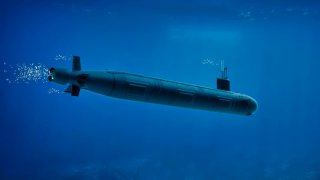SSN(X): The U.S. Navy Submarine That Could Dominate Everything
The U.S. Navy needs the SSN(X) submarines to keep up with attack subs from both China and Russia in the decades to come
SSN(X) Submarine Primer: As tensions between Beijing and Washington continue to ramp up, the development and role of advanced fighter platforms have been elevated. For many years, the U.S. retained an air superiority fleet over its adversaries. When the F-22 Raptor was introduced several decades ago, the platform would become the world’s first ever fifth-generation platform to take to the skies. However, now that China and Russia possess their near-peer fighters - the Chengdu J-20 and the Sukhoi Su-57- the balance of power in the aerial space is shifting. To rectify this, the U.S. Air Force has been steadily prioritizing its Next Generation Air Dominance Program (NGAD). This sixth-generation fighter platform is expected to blow competitors out of the water once introduced to service.
While advancing the military’s aerial capabilities is necessary in light of looming conflict, the U.S. Navy is also working towards its own next-generation submarine program.
Dubbed SSN(X),the Next-Gen Attack submarine will represent the subsequent class to the nuclear attack Virginia and Seawolf ships.
The history of the SSN(X) program:
Back in 2014, the U.S. Navy first conceptualized what a next-generation submarine class would require.
The service hoped to conduct a complete analysis of the SSN’s design by 2024 and to begin construction on the ships one decade later. Over the next few years, the Navy would work out the capabilities and features needed to make these next-gen submarines formidable.
Last year, the Navy’s budget request for Fiscal Year 2022 included nearly $30 million for the general class development of its new submarine, in addition to more than $68 million for developing its nuclear propulsion.
Since Fiscal Year 1998, the Navy has been procuring Virginia-class submarines at a rate of two boats per year. The latest block V Virginia-class variants are equipped with the Virginia Payload Module (VPM) and cost roughly $4.3 billion per both. The Virginia-class SSNs were notably the first submarines ever to serve the U.S. Navy that were developed using aids such as the 3D visualization technology CATIA, which consists of computer-aided engineering, computer-aided design, computer-aided manufacturing and product lifecycle management. The two manufacturers that continue to produce the Virginia-class ships, Newport News Shipbuilding and Electric Boat (a subdivision of General Dynamics), will also construct the SSN(X)-class submarines down the line as they are the only facilities with the capacity to build nuclear-powered SSNs.
In its Fiscal Year 2022 budget request, the Navy detailed how a next-generation submarine class would be different from its Virginia-class predecessors. The service explained that the SSN(X) would be designed primarily for increased transit speed under greater stealth conditions in all ocean environments, in addition to carrying a more comprehensive array of payloads. The Virginia-class submarines, on the other hand, were designed primarily for multi-mission dominance in the littoral.
The SSN(X) will also be designed to carry out multi-mission functions with a “renewed priority” in the antisubmarine warfare (ASW) mission against threats in larger numbers.
What we know about the next-generation submarine program:
Other details surrounding the next-generation submarine have yet to be released by the Navy.
Over the next few years, the service will likely evolve its exact specifications as the project is still in its early stages of development. Some analysts predict that the new fast attack boats could be fitted with additional torpedo tubes, larger flank arrays, laser weapons, quantum technology, a quieter electric drive propulsion, and other enhancements.
The latest Congressional Research Service report also detailed that the SSN(X) will incorporate characteristics of the three primary submarine classes currently in commission with the Navy. According to the report, “the speed and payload of the Navy’s fast and heavily armed Seawolf (SSN-21) class SSN design, the acoustic quietness and sensors of the Virginia-class design, and the operational availability and service life of the Columbia-class design."
The Seawolf-class submarines have been commissioned since the late 1990s. As the intended successor to the Los Angeles-class ships, these subs were designed with the threat of sophisticated Soviet ballistic missile submarines in mind. The Seawolf boats can travel at 20 knots silently and up to 35 knots at a maximum. The Virginia-class is the latest class of nuclear-powered fast-attack submarines. Designed with enhanced acoustics, sensors, and quieting technology, these boats are difficult to detect underwater. The Columbia-class ships represent the upcoming class of nuclear-powered ballistic missile submarines designed to replace the aging Ohio-class vessels.

With an expected service life of more than four decades, these ships are being built to stand the test of time.
About the Author
Maya Carlin is an analyst with the Center for Security Policy and a former Anna Sobol Levy Fellow at IDC Herzliya in Israel. She has by-lines in many publications, including The National Interest, Jerusalem Post, and Times of Israel. You can follow her on Twitter: @MayaCarlin.


